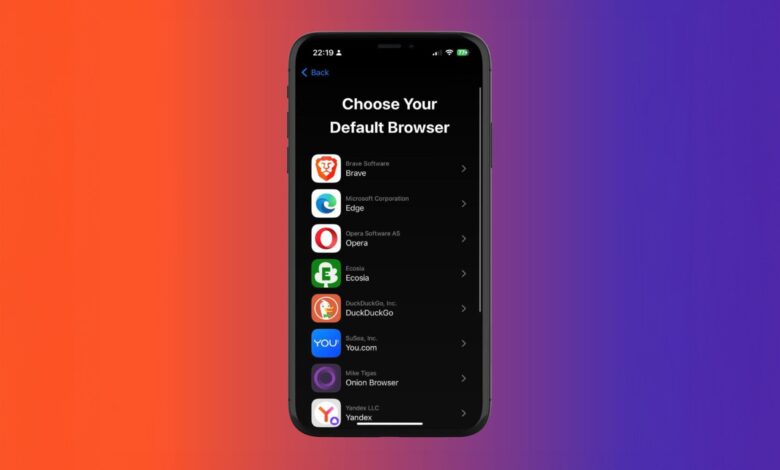Apple’s iPhone Browser-Choice Option Sucks. Its Competitors Have Ideas to Improve It

You just bought a new iPhone in Europe and finished setting it up. You’re excited to start planning a much-needed vacation, so you tap on the Safari browser to search for upcoming flights. Oh, you suddenly see a pop-up asking you to choose a default browser. You quickly scan the list of options, only recognizing one or two, then decide to keep Safari and move on with your hunt for travel deals.
With the iOS 17.4 update, Apple now includes a default browser selection pop-up screen for European iPhone users. It’s part of the company’s response to the Digital Markets Act, which EU lawmakers enacted earlier this year to encourage competition on the internet. (The browser choice screen is not currently rolling out to iPhones in the United States.) While browser choice screens are, in theory, meant to level the playing field in markets dominated by a handful of gatekeepers, their effectiveness is determined by the quality of the user experience.
Many of the competitors appearing on Apple’s browser choice screen are dissatisfied with how it’s been implemented in European markets. Brendan Eich, CEO and cofounder of Brave, compared powerful companies that control the defaults on smartphones to street magicians who fan out cards to pick from but hustle you by forcing a specific card to the top of the deck.
An Apple spokesperson requested to speak off the record about browser choice screens. When WIRED declined and asked for an on-the-record comment, all further requests for an interview went unanswered.
Whenever someone updates their software to iOS 17.4 in Europe, they may see the browser choice pop-up the first time they tap on the Safari browser. After a short introductory screen about the default browser choice, a list of 12 browser options are displayed in a random order. The browsers that appear on the list vary slightly by country. Safari is automatically included, and the 11 other picks are browsers with the most iPhone downloads in a particular country that also adhere to Apple’s configuration requirements for defaults.
“It starts from you clicking Safari,” says Jon von Tetzchner, CEO and cofounder of Vivaldi. “Which, I think all of us agree, that’s the wrong spot.” Tetzchner said he prefers Google’s implementation of its new browser choice screen that guides Android users to select a default while setting up their phone.
Google actually has some experience implementing a choice screen to appease European regulators. When it was forced to add a search engine default selector to Android in 2019, many of the developers behind alternative options initially criticized the design and denounced Google’s practice of selling slots on the screen through auctions. The company responded by rolling out an updated pop-up without slot auctions in 2021. Google did not respond to multiple requests for comment on this story.
The slow speed of enforcement from European regulation means any changes mandated by lawmakers only arrive after a drawn-out process. “Google had implicit permission to implement a bad version of it and run out the clock. In the process, it makes the entire remedy of a choice screen look bad,” says Kamyl Bazbaz, a vice president of public affairs for DuckDuckGo. “If you can only judge the effectiveness of a thing based on a bad version of it, you’re gonna think it sucks.”
A few representatives from smaller browser companies also expressed that they wanted more information included with Apple’s choice process, like definitions of what a browser is for less tech-savvy users and descriptions of the different browsers’ specialties. “Giving people information about the choice, and also information about what they’re choosing is really, really important,” says Kush Amlani, a global competition and regulatory counsel at Mozilla, which makes the Firefox browser.
Sophie Dembinski, a head of public policy and climate action at Ecosia, mentioned how Apple’s pop-up appears for all iPhone users even if they’ve already gone into their phone’s settings and set an alternative browser as their default. In comparison, Google’s browser choice screen for Android users won’t show up if you’ve already gone through the steps of setting a preference for a third-party option.
While many developers are unhappy with Apple’s implementation, not every company with a browser on the choice screen expressed frustration. “We believe that Apple’s approach to presenting the browser choice screen is fair and acceptable,” says Andrew Moroz Frost, the Aloha Browser founder. He pointed out the randomized order of the browsers shown on the pop-up as one example of Apple designing it in a fair manner.
Richard Socher, the founder and CEO of You.com, seemed more encouraged by there being a browser choice screen that includes the search-focused startup rather than frustrated by Apple’s implementation. “I think it’s great that there’s not the default already preselected,” he says. Socher highlighted the randomized order as a positive sign as well.
Is this choice screen a true turning point for alternative browsers to grow their user base? “We’re expecting to have a clear picture on user uplift within months, not weeks,” says Dembinski. While some browsers reported initial upticks in downloads, it still seems too soon to make sweeping generalizations about the long-term efficacy of Apple’s choice screen.
“We would like to encourage platform providers to also level out the playing field for app developers around the world, not just in the EU,” says Jan Standal, a vice president of product marketing at Opera. Some of the companies WIRED spoke with remain hopeful that the precedent of browser choice screens set by the DMA will inspire international software changes.
Shortly after Apple’s choice screen launched, the European Commision announced that the screen would be part of its wider investigation into how Apple, Google, and Meta might be breaking these updated regulations: “The Commission is concerned that Apple’s measures, including the design of the web browser choice screen, may be preventing users from truly exercising their choice of services within the Apple ecosystem, in contravention of Article 6(3) of the DMA.” In keeping with its slow-moving tradition, this investigation may take up to a year to complete.


